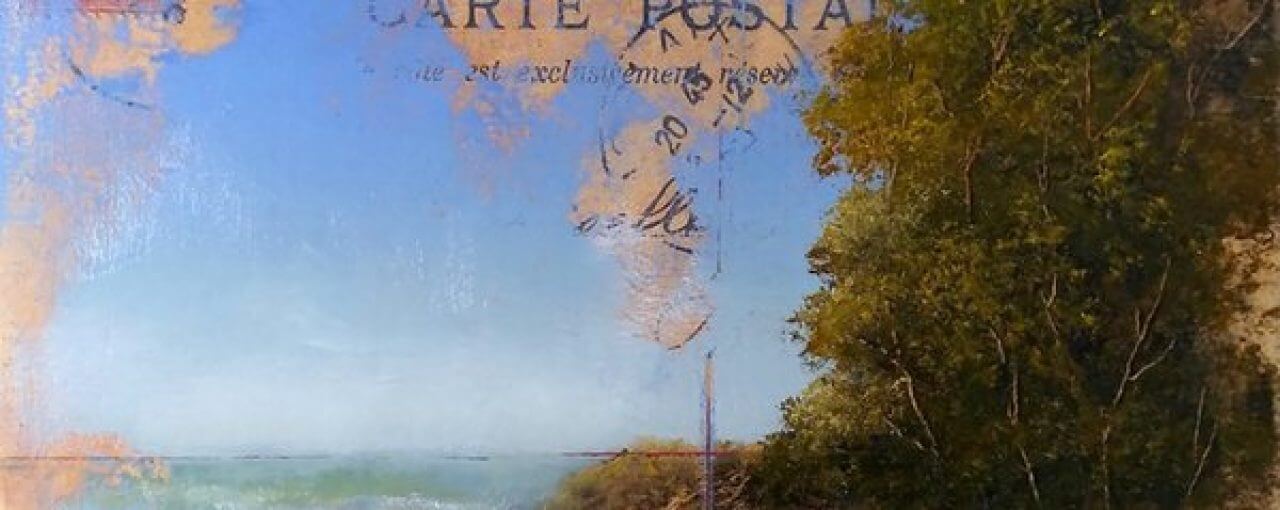Contemporary Landscape Collage
Interview by Jennifer Nelson, WTP Feature Writer
For the past thirty years, Greg Skol has been an artist, working in Los Angeles and San Francisco before eventually settling in Santa Fe, New Mexico in 1990. His artwork has been exhibited in New York, Los Angeles, Seattle, Austin, and other cities. The Albuquerque Museum; Museum of the Southwest in Midland, Texas; Springfield Museums in Springfield, Massachusetts; and Knoxville Museum of Art have all collected his work. His paintings and collages have been featured in periodicals and books, including New American Paintings, Art Journey New Mexico, Southwest Art, American Art Collector, and Design & Architecture. His artwork is held in numerous private and corporate collections. He studied at the School of Visual Arts and The Art Students League of New York.
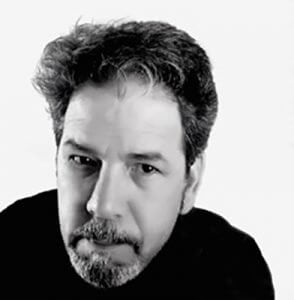
Nelson: As a child, you became interested in art, immersing yourself in drawing, music, and books, even drawing from the Encyclopedia Britannica. How did this, so early on, begin to shape you as an artist, as well as growing up in New York City?
Skol: I never thought about doing any of the things I did as a child, I just did them. It was without forethought (or any thought, really). I was interested in things and I followed those interests. Only in retrospect can I begin to guess how those early “interests” shape one as an artist. I certainly had no thought of myself as an artist for a very long time.
The one shaping influence that I can draw a line (pun not intended) from childhood to the work I have done as an adult artist is the interest in intimacy in work, which relates to the scale I have mostly worked in. With one’s nose in a book or a drawing pad, one retreats into a personal, intimate world. I suppose the small works have the same effect for me as maker and, hopefully for the viewer.
As for growing up in New York City, that is my only frame of reference for childhood. As an adult, I can see that I had access to not only art museums and later galleries as those proliferated, but exposure to music of all kinds. Later, I would have exposure to adults who were artists, writers, and musicians, which I suppose was not the case for children growing up in other parts of the country. Again, none of this was “odd” to me; it was just a matter of where I lived.
Growing up during the 1960s and 1970s in New York City, the counter-culture revolutions were probably more pronounced and visible. I’m sure that had some influence on all of us growing up there—a richly, diverse, intensely unique as well as rough-and-tumble environment.
Nelson: In the series Places Between Places and Paper Towns, you use oils to depict traditional landscapes. What are the advantages of oils, and how did Thomas Cole, founder of the Hudson River School, influence your work? What other artists have influenced you?
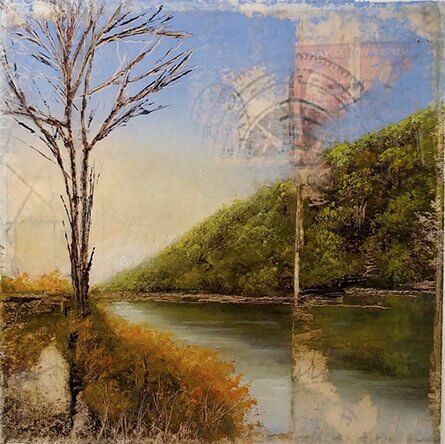
Skol: I like oil paint. Oils are very forgiving. The medium allows for a very long “working” time, in which things can be changed days into the process. I like other media as well, but oils suit me and the way I work, which can be slow at times. I also like the smell of linseed oil. It reminds me of my grandfather’s cabinet-making shop where he used linseed oil on his pieces.
Thomas Cole and the Hudson River School are a big influence for most representational landscape painters. They infused the work, the paintings of the landscape with ideas other than mere verisimilitude. They felt there were larger, sometimes spiritual aspects revealed through nature and light.
Cole’s method of working from memory was something that rang true for me as well. Working from photographs or painting on site gives you certain ways of seeing; working from memory gives you another way. For me, working from memory means that you need to be infused with the image, the place, the feeling of it, and so the work becomes infused as well. Hopefully. As for other influences, they are too numerous to even begin to do justice in listing.
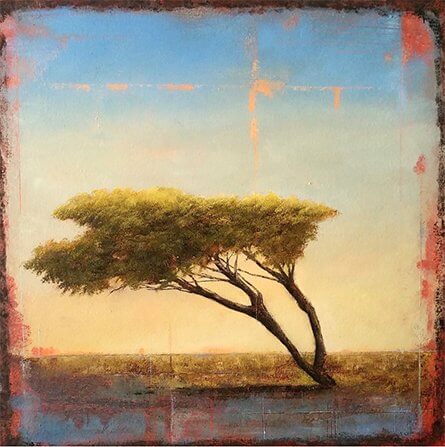
Nelson: In your latest series Dead Letter Office, you take discarded postcards bearing postage stamps, partial addresses, and postmarks, and paint scenes from nature on them. Where did you find these old postcards, and what techniques do you use to create images that feature splotches of color, blurred trees and rivers, and lines that look like creases?
Skol: The Dead Letter series is one that links back to the early days after art school when I did collage works. I worked in a unique photography bookstore in Soho in the early ’80s, where there were not only books—new, old, out-of-print ones, as well as old photo equipment and old prints of various antique methods. There were also old cabinet photos and postcards made from those. For a long time I collected those to use in my collage work. As for today, much of that material is scanned and printed and those are used instead of the originals. Of course, all of that material is now available at the click of a mouse, from all over the world.
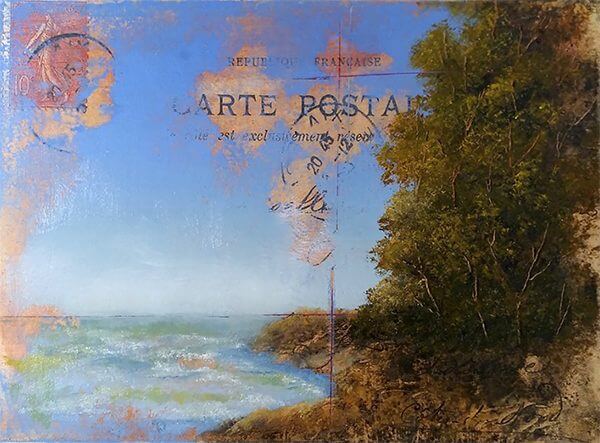
Nelson: What was your inspiration for the series Ghost Towns, in which half of a small panel is a landscape and the other half a deserted village?
Skol: The Ghost Towns series also came out of the early collage work. When I decided I needed more than just straight landscapes, I reviewed works I had done previously. The abandoned houses and villages seemed to add something of a statement about the idea of place that I was exploring in the landscape paintings—something at once contemporary and historical, as well as new and old.
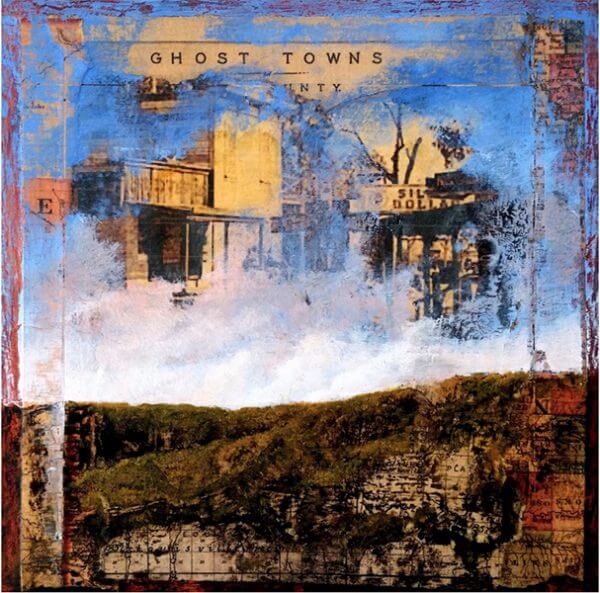
Nelson: Your artwork is often sized quite small. For example, “She Sells Seashells (After Vermeer)” from your The Nature/Nurture Project series, is a 7.5 x 7.5-inch image that uses mixed processes. How is this small size conducive to the effects you’re looking to achieve, and can you comment on the materials used in this series?
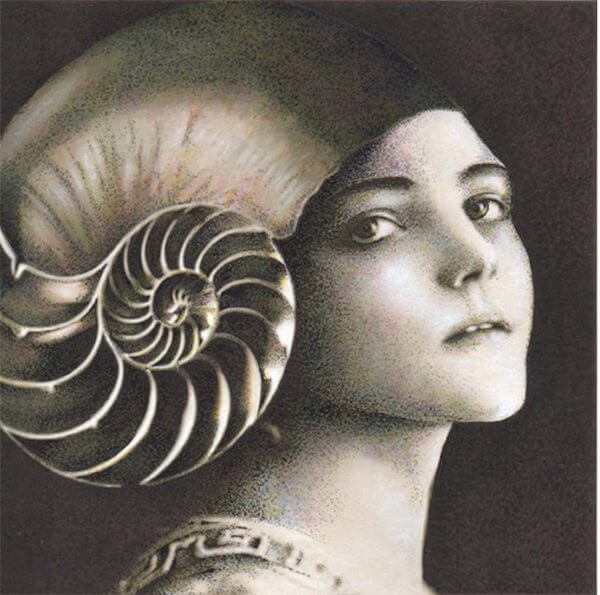
Skol: Scale seems to be directly related to my early days of having my nose in books and drawing pads. Perhaps a sort of sanctuary from the world I was living in? Later, working at the photography bookstore, I would again have my nose buried in books (as I seem to always have done), which is when I started doing the small collage works. The materials mostly dictated the scale at that point—old magazines, books, and photographs. I also used discarded portions of larger works from earlier experiments in painting, printmaking and my own photography. All of these factors determined the scale of the work and for whatever reasons, seemed suited to me.
Nelson: In 2013, you revisited your collage and mixed media works from the ’80s. What are the advantages of this medium, and how do your recent collages differ from earlier ones?
Skol: When I revisited the early collage works, I was looking for something…perhaps looking to regain something that had been abandoned in favor of painting. I had done hundreds of landscape paintings and when the general economy and art market collapsed around 2008–09, I found myself with a lot of unsold inventory. I also found myself wondering what I needed to say in my work beyond just making work for the market. In some ways, the landscapes seemed to have run their course, or maybe I had just run my course with them?
The early collage work was done from a need to express something deeper; I wanted to infuse my new work with that energy. As in Thomas Wolfe’s book title You Can’t Go Home Again, the person that made those collage works was not the same person looking at them decades later. But there was something to be gleaned from them. The newer experiments in collage that have been part of the intersection between my new works, the landscapes, and the old works from the ’80s are the result of what materials are at hand. When there were used bookstores and no internet, we used what we had available; since those are few and far between, we use what is available now, including public domain images and scans.
I wouldn’t use the originals of any of these images now as they are too hard to come by and should be preserved as they are. So, the newer experiments in collage (grown out of the Ghost Towns, Paper Towns series) were a way to alter and collage images without destroying the original material. I often wonder what the surrealists, especially Max Ernst, would have thought about Photoshop! Probably the same as many of us do now—ambivalent. But we use the tools we have at hand. The newer collage works (photomontage, really) are subtler than the early ones. The early ones were done by a very young artist and these are done by an artist with more than thirty-five years of experience of life, making, and a Mac. I think the difference can be spoken for by that simple idea.
Nelson: How do you see your artwork evolving in the future?
Skol: I don’t engage in thinking about the evolution of the work. Ideas come, things tried. Some lead to something, some do not. I take what is interesting and works and add them. Sometimes things that didn’t seem to work will be picked back up later and added and used. There would have been no way for me to imagine my work and my life now from the perspective of the twenty-something artist making collage works. I will say, though, that I would hope that the growth and experimenting and seeking will lead to more interesting works, evolved from the here and now.
See Greg Skol’s work in WTP Vol. VI #6.
Copyright 2018 Woven Tale Press LLC. All Rights Reserved.

